
Just below the Bird’s Head (the western tip of the island of New Guinea) in the Indonesian province of West Papua, in the McClure Gulf, is a small village known as Arguni. This is the regency of Fak Fak – pronounced Fuk Fuk. Arguni sits in a bay dotted with limestone outcrops and uplifts. These tiny limestone islands are not uncommon through out the Asia-Pacific. Similar bays filled with similar islands can be found in Marovo Lagoon in the Solomon Islands, or in the Ang Thong Marine Park off the coast of Thailand for example. But what is of particular interest on these limestone outcrops of ancient reefs, is the artwork that, in time gone by has been painted on their surfaces.
 The Bird’s Head is the western tip of the island of New Guinea, the regency of Fak Fak sits just below on the McClure Gulf
The Bird’s Head is the western tip of the island of New Guinea, the regency of Fak Fak sits just below on the McClure Gulf
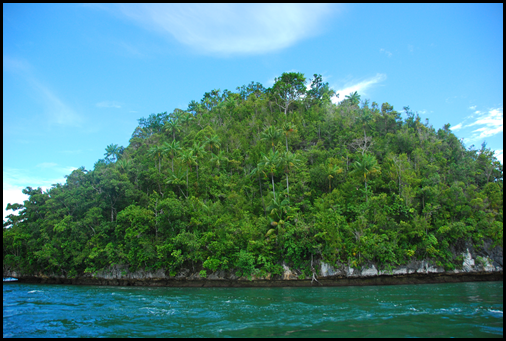 Typical limestone outcrop in the area around Kokas, Andamata and Arguni
Typical limestone outcrop in the area around Kokas, Andamata and Arguni
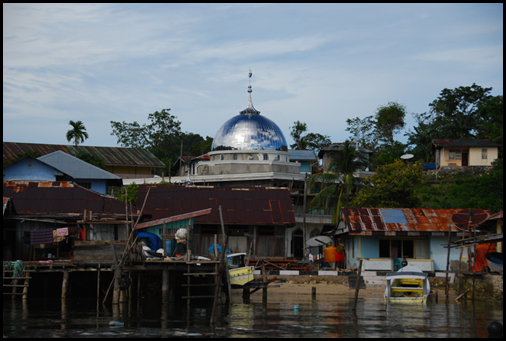 The village of Arguni, Fak Fak
The village of Arguni, Fak Fak
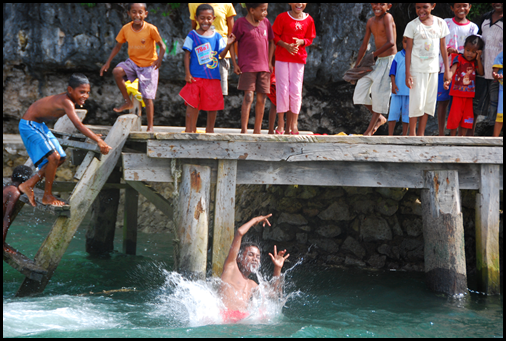 Kids from the village of Andamata
Kids from the village of Andamata
For some reason in our human nature, ancient rock art stirs debate and theory. Similarities in ancient rock art styles in geographically distant locations has spawned claims of ancient Egyptian fleets or Phoenician vessels encircling the globe, leaving their mark in rock art. Others have gone as far as to claim that certain rock art done by primitive peoples describes the arrival of visitors from outer space. Issues arise in dating rock art. Can you effectively date the art or are you simply dating the rock it is drawn upon? Controversial techniques such as dating the age of mud wasp nests attached to the rock on top of the art, as was used in West Australia’s Kimberley, can apparently give indications back tens of thousands of years and contribute to dating rock art. Indeed it is in the Kimberley of Western Australia where some of the most controversial art is found.
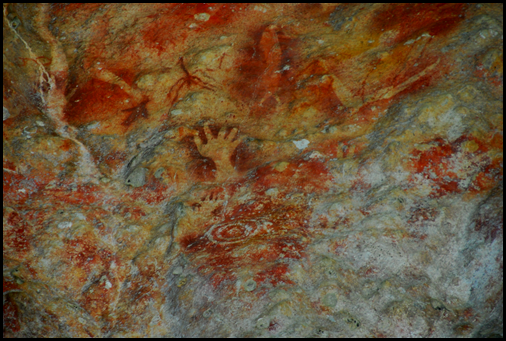 Typical “panel” of rock art between Arguni and Andamata
Typical “panel” of rock art between Arguni and Andamata
Many a researcher has spent many a day, studying and theorising over the ancient art of the Kimberley. Within the different styles of art found in the Kimberley, the style drawing the most interest is the Bradshaw or Gwion art. Bradshaw was a pastoralist who located and described much of this style, whilst Gwion is an Aboriginal language word for a small bird, believed in their mythology to have painted this art with his beak. Some researchers go as far as to separate the Gwion and the Bradshaw as two separate styles. Without a doubt, the art most commonly recognised as Gwion-Bradshaw covers many different styles over a large time frame. Without entering into the great debate it is fairly safe to say that the older of the Gwion-Bradshaw style originates from around 15,000 – 25,000 BCE. Many theorists will claim it as even older, but that time frame falls into the most acceptable theories. The fact that following generations have painted over older existing art complicates the issue as well.
 A pair of “Tasselled Bradshaw” figures, near Mangalalu-Truscott on the Anjo Peninsula, are classic examples of the Gwion-Bradshaw style in Western Australia.
A pair of “Tasselled Bradshaw” figures, near Mangalalu-Truscott on the Anjo Peninsula, are classic examples of the Gwion-Bradshaw style in Western Australia.
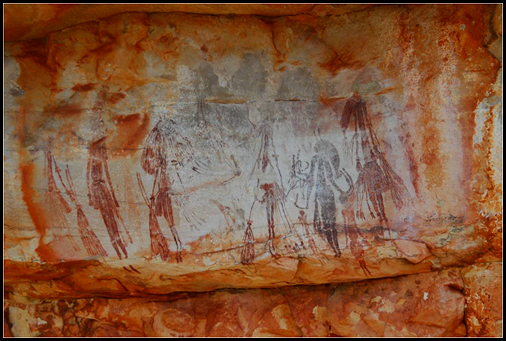 A great selection of figures in the Gwion-Bradshaw style photographed near Mangalalu-Truscott in 2007 on the Anjo Peninsula in the Kimberley region of Western Australia
A great selection of figures in the Gwion-Bradshaw style photographed near Mangalalu-Truscott in 2007 on the Anjo Peninsula in the Kimberley region of Western Australia
So what has this got to do with the limestone islets of the McClure Gulf? Well you see much of the older art of the McClure Gulf bears striking resemblance to the Gwion-Bradshaw art of the Kimberley. Grahame Walsh, respected Gwion-Bradshaw researcher described many variations of Gwion-Bradshaw's and mapped them to a time scale – this time scale and level of variations matches almost identically what can be found in West Papua. But why is this so? Quite simply in the time frame that we are talking about, Australia and New Guinea were linked as the great continent of Sahul. Sea Levels were lower, and modern DNA research shows us that the earliest migrations across to the Sahul Shelf from Java were the common fore-fathers of both the Aborigine in Australia and the Papuans in New Guinea.
 A map showing the continent of Sahul, joining Australia and New Guinea prior to the last major climate change that saw sea levels rise and Australian and New Guinean development separate and differentiate with Australia becoming hotter and drier and New Guinea becoming hotter and wetter.
A map showing the continent of Sahul, joining Australia and New Guinea prior to the last major climate change that saw sea levels rise and Australian and New Guinean development separate and differentiate with Australia becoming hotter and drier and New Guinea becoming hotter and wetter.
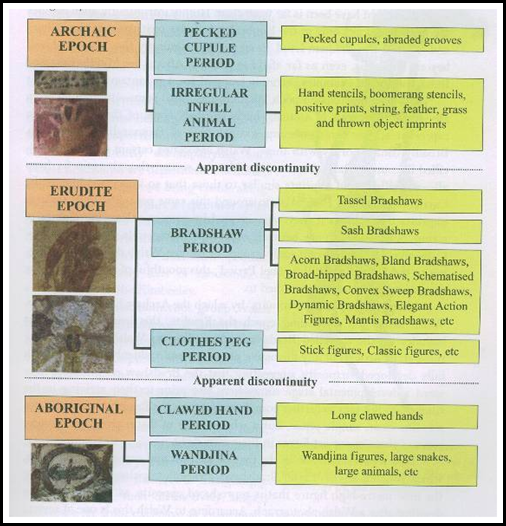 Grahame Walsh, one of the most respected Gwion-Bradshaw researchers used the above table to give a timeline to the different art styles found in the Kimberley, which mimics the styles found in West Papua up to Walsh’s Erudite period (Table by Grahame Walsh)
Grahame Walsh, one of the most respected Gwion-Bradshaw researchers used the above table to give a timeline to the different art styles found in the Kimberley, which mimics the styles found in West Papua up to Walsh’s Erudite period (Table by Grahame Walsh)
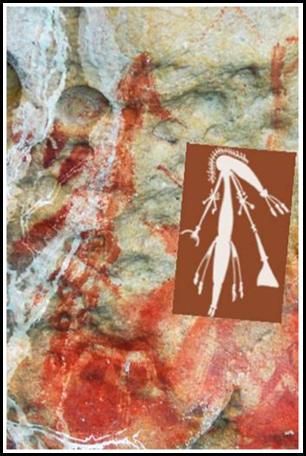 A Tasselled Bradshaw type figure in the McClure Gulf near Arguni, beside a drawing of a typical Kimberley styling from the Bradshaw Foundation
A Tasselled Bradshaw type figure in the McClure Gulf near Arguni, beside a drawing of a typical Kimberley styling from the Bradshaw Foundation
 Tasselled Bradshaw's, Boomerang Stencils, Stick Figures, all of the same kind found in the Kimberley albeit no longer as well preserved on the limestone in McClure Gulf as one would find on the sandstone of the Kimberley
Tasselled Bradshaw's, Boomerang Stencils, Stick Figures, all of the same kind found in the Kimberley albeit no longer as well preserved on the limestone in McClure Gulf as one would find on the sandstone of the Kimberley
So looking at the Sahul shelf & the great continent it’s easy to see why the art of McClure Gulf and the art of the Kimberley had the same roots. Together with the DNA studies mapping human migration, it all adds up. But then what happened? The art changed. After a disconnected period the Wandjina style appears in the Kimberley and other styles appear in the Papua region. What happened was major climate change. The ice age had ended, sea levels were rising the whole landscape was changing dramatically. Imagine the effect this would have on the populations and the “communities” they existed in. The controversy of the origin of Gwion-Bradshaw art in the Kimberley has been compounded by people like Walsh using their time line to differentiate between style, or more specifically, Walsh’s use of the name “Aboriginal Epoch” to describe the timing of the Wandjina style. This has led to numerous theories of a mysterious pre-Aborigine “race” that produced the Gwion-Bradshaw and then disappeared to be replaced by later migration of the Aborigine who produced the Wandjina. This has been compounded by several Aboriginal communities claiming no link to the ancient Gwion-Bradshaw style of art. This is not universal amongst the Kimberley Aboriginal people however. Although several high profile personalities have been vocal on the matter, and various subjects spoken to and interpreted in the writings of people like Walsh claimed no link, the elders of the Wunambal-Gaambera around Kulumburu retold many stories linking the Gwion-Bradshaw with their dreamtime oral history to me as recently as 2007.
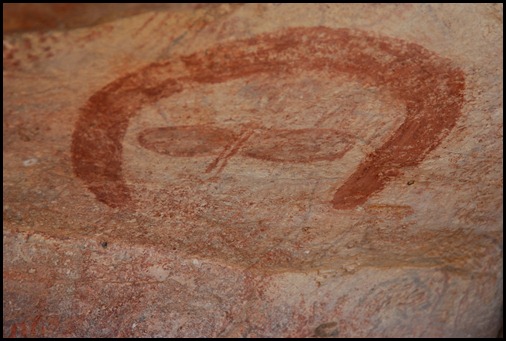 The Wandjina style found in the Kimberley, like this depiction from the Anjo Peninsula came after the period of climate change and sea levels rising and is not found in the Papua region
The Wandjina style found in the Kimberley, like this depiction from the Anjo Peninsula came after the period of climate change and sea levels rising and is not found in the Papua region
So basically what happened between the Gwion-Bradshaw art with the similar styles in Papua and Australia and then the differentiation of styles between the two regions is all linked into these major climatic events. Along with climate change came trans-migration between the two areas, resettling to accommodate the changes in weather, moving further inland over generations as sea levels began to rise. Changing diets and hunting habits as the environment changed, all changing the populations. Again modern DNA research supports this, although there is still debate about how many entry points there were, there was never a pre-Aborigine “race” that disappeared, it was all part of the migrations and trans-migrations matching with the events of climate change over tens of thousands of years. And the art matches this. Whilst tens of thousands of years ago they were all painting along the lines of the Gwion-Bradshaw, by the time the Wandjina style came into the Kimberley, Papua had been separated by water for thousands of years and their contemporary styles varied from what was appearing now in the Kimberley. So mean while over in Papua time moved on. The local Papuans continued painting, bringing in elements of their own developing mythology. One figure appearing in their art is known as “Maturo”, a half man-half lizard.
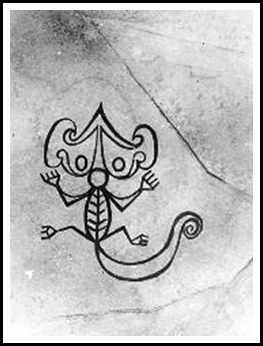 The long tailed Maturo figures found in Papuan art, half man-half lizard, is of a much later period then the earlier Gwion-Bradshaw found both in Papua and the Kimberley region in Australia (image from Papua Cultural Heritage Foundation)
The long tailed Maturo figures found in Papuan art, half man-half lizard, is of a much later period then the earlier Gwion-Bradshaw found both in Papua and the Kimberley region in Australia (image from Papua Cultural Heritage Foundation)
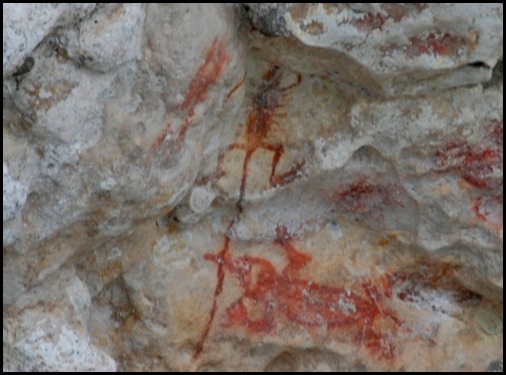 Long Tailed Maturo figures, of a later period then the Bradshaw-Gwion figures, near Arguni
Long Tailed Maturo figures, of a later period then the Bradshaw-Gwion figures, near Arguni
The Papuan people of the McClure Gulf didn’t believe in burying their dead, they were placed in the limestone caves along the cliffs, the same locations that house generations of Rock Art. Today very few Papuans live in the area of Kokas-Arguni. Legend has it that the original tribes were all but wiped out by tribal war. This bloody history also lends its self to the myth that the rock art is painted in the blood of war victims, and that hand stencils were from severed limbs held as stencils celebrating the victory of war. Today most of the inhabitants of Kokas and Arguni are Buginese or Makassans from Sulawesi who transmigrated in the last few hundred years. Others came as part of Suharto’s Transmigration programs and more recently with the lure of work from the oil and gas operations popping up along the McClure Gulf. The shiny silver domes of the numerous village mosques stand in contrast to the caves filled with ancient rock art only a few hundred metres apart.


 the Bamboo Dance, where participants dance and dodge moving poles of Bamboo is common through out South East Asia including in the Philippines and Cambodia and other parts of Indonesia. It is not however found in the repertoire of ethnic Papuans.
the Bamboo Dance, where participants dance and dodge moving poles of Bamboo is common through out South East Asia including in the Philippines and Cambodia and other parts of Indonesia. It is not however found in the repertoire of ethnic Papuans.
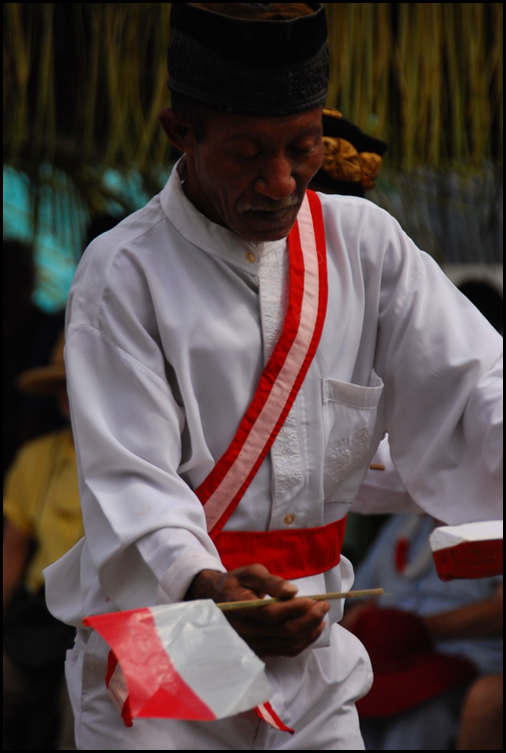 A Kokas Man dances in the national colours of Indonesia symbolically celebrating the separation from Colonial Powers and the independence of Indonesia
A Kokas Man dances in the national colours of Indonesia symbolically celebrating the separation from Colonial Powers and the independence of Indonesia
 The tiny township of Kokas was used as a secret underground command centre by Imperial Japanese forces during World War II
The tiny township of Kokas was used as a secret underground command centre by Imperial Japanese forces during World War II
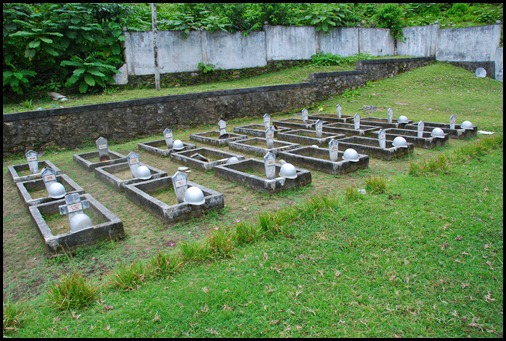 The military cemetery in Kokas reminds us that long after the end of WWII and the independence of Indonesia, conflict has continued. Both the 27 years of conflict in Timor that ended in 1999 and the ongoing conflict through out Papua has taken lives, even in a small town like Kokas.
The military cemetery in Kokas reminds us that long after the end of WWII and the independence of Indonesia, conflict has continued. Both the 27 years of conflict in Timor that ended in 1999 and the ongoing conflict through out Papua has taken lives, even in a small town like Kokas.
So when one takes into account the facts that we have available regarding human migrations, climate change, changing sea levels and the like, it is really not that mysterious that similar rock art styles are found in both the North West of Australia and in places like the McClure Gulf in Indonesia’s Papua Province.

Photographs of the traditional rock art on the Anjo Peninsula around Mangalalu-Truscott in Western Australia were taken with permission of the traditional owners, the Wunambal Gaambera people, in 2007.

So you want to go to Kokas and Arguni?
- Get yourself into either Bali or Jakarta as entry points to Indonesia
- Take a domestic flight – there are several airlines available - to West Papua Province, you may have to fly through Sorong or Jayapura to end up in Fak Fak
- Fak Fak has only one real decent hotel, the Grand Papua. It’s nothing special but its comfortable. The food is pretty good here too.
- From Fak Fak you want to get a car/driver/guide to get you to Kokas. The hotel can arrange or visit a local tour agent. Allow a couple of hours driving time and the road will take you right to Kokas
- From Kokas simply head down to the wharf and negotiate a long boat to take you out to the art work. Allow 2-3 hours.
- There is a guest house or two in Kokas but it’s just as easy to do it as a day trip and return to Fak Fak for the night.
View Kokas in a larger map
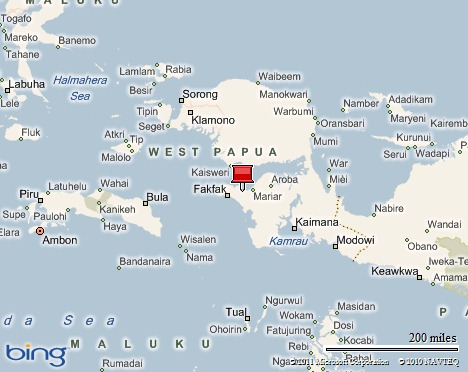
No comments:
Post a Comment